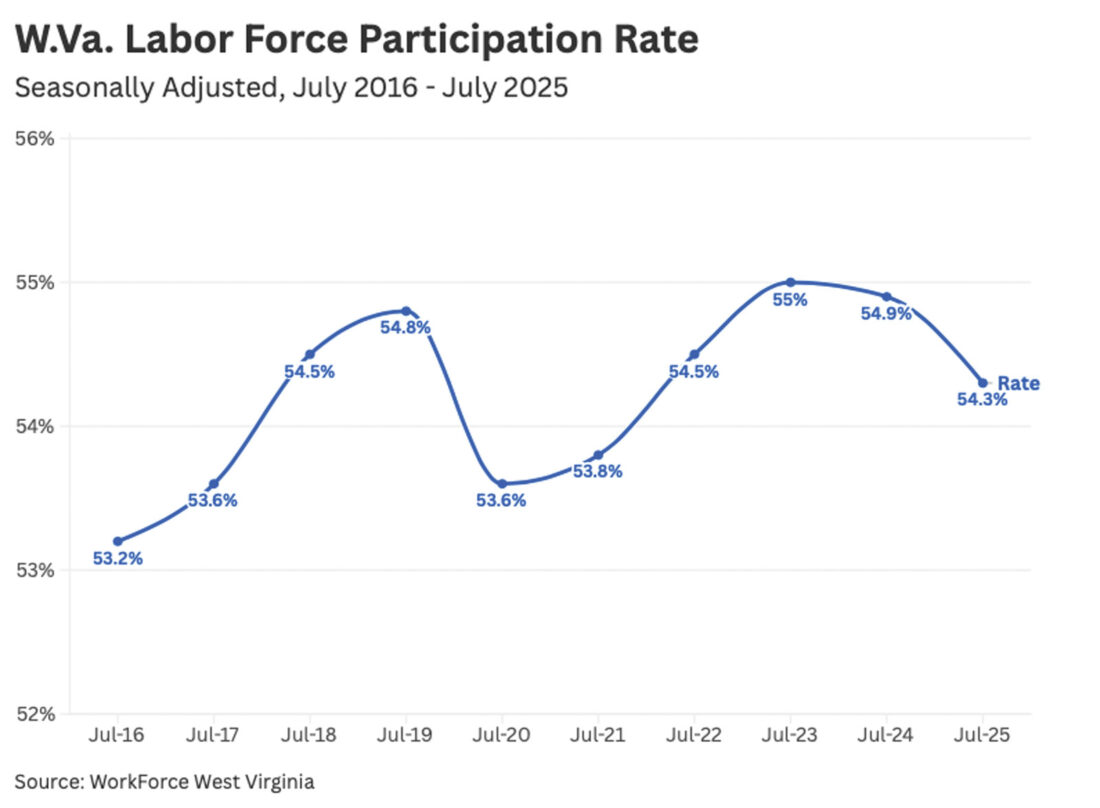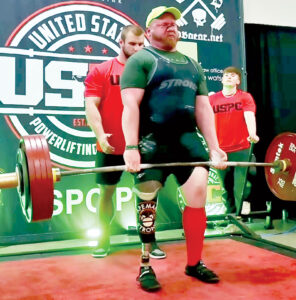Business community raises alarm over decreasing labor force participation in West Virginia

CHARLESTON — West Virginia’s labor force participation rate peaked at 55% following an extreme drop following the COVID-19 pandemic, but a steady drop in both labor force participation and increases in unemployment caused the leader of the state’s business community to raise alarms.
In a press release Monday, West Virginia Chamber of Commerce President Steve Roberts cited the latest employment and hiring numbers released last week by WorkForce West Virginia showing a decrease in civilian workforce numbers.
“These numbers are troubling,” Roberts said. “We’re seeing consistent signs of economic softening across several core industries. When the workforce is shrinking and job losses are sustained over time, we must treat it as a warning sign, and we must respond with urgency.”
According to WorkForce West Virginia, the state’s seasonally adjusted labor force participation dropped by 7,600 workers, from 787,600 in July 2024 to 780,000 last month. Civilian labor force numbers measure the total number of people age 16 and older who are either employed or seeking employment. Seasonally adjusted numbers take into account predictable fluctuations in employment.
West Virginia’s civilian labor force peaked in the last decade at 795,800 in the final two months of 2019. Prior to the COVID-19 pandemic in the spring of 2020, the state’s labor force participation rate peaked at 54.8%. When the pandemic first hit towards the end of March 2020, non-essential businesses were forced to shut down for between 30 and 40 days to control the spread of the virus.
The labor force number in the state dropped from 790,500 in March 2020 to 760,800 in April 2020, with the seasonally adjusted unemployment rate dropping from 5.3% to 15.8% between those two months. The unemployment rate measures those who are currently unemployed but still seeking work.
Despite the drastic hit in unemployment and labor force participation due to COVID-19 shutdowns, more people taking precautions when shopping, and social distancing guidance limited how many people could be in businesses at any given time, labor force numbers began increasing in the months following and the unemployment rate steadily dropped.
The unemployment rate dropped to a low of 3.5% in February and March 2023. By August 2023, labor force numbers peaked at 790,200 in October 2023. The unemployment rate has fluctuated since then, remaining at 3.7% since May. According to WorkForce West Virginia’s number and the state Chamber of Commerce, the state has experienced declines in total employment for 14 months in a row.
The chamber’s analysis of WorkForce West Virginia found a slight increase in private sector employment numbers, from 565,900 jobs in 2024 to 567,500 jobs in 2025. However, the chamber found several decreases in employment in several private sector anchors of West Virginia’s economy between 2024 and 2025.
These include a decrease in mining employment from 21,300 jobs to 20,700 jobs; a decrease in manufacturing employment, from 45,600 to 45,400; a decrease in hospitality employment, from 71,400 to 68,700; and a decrease in retail employment, from 78,400 to 77,800.
According to a state-by-state comparison of June seasonally adjusted labor force participation rates St. Louis Federal Reserve, West Virginia once again has the worst rate in the nation at 54.2%, often flipping spots for worst with Mississippi. Compared to neighboring states, Kentucky’s labor force participation rate was 58.4%, Maryland’s was 64.7%, Pennsylvania’s was 61.5%, Ohio’s was 62.7%, and Virginia’s was 65%.
“West Virginia is not keeping pace with the region or the nation,” Roberts said. “This should concern every leader in our state.”
According to the most recent West Virginia Economic Outlook report published by the Bureau of Business and Economic Research at the John Chambers College of Business and Economics at West Virginia University, employment in the state is expected to stay relatively flat through 2029.
“This lags the nation, which is expected to add jobs at an average annual rate of 0.5 percent over the forecast period,” the report stated. “Major drivers of this slow growth are the lingering effects of high interest rates, fundamental demographic challenges, and severe weakness in many of the state’s counties.”
The report estimates that West Virginia’s unemployment rate could increase to 5% by 2026 and 2027. Though that increase will come from older residents re-entering the workforce and new jobs offering higher wages.
“Much of this upward movement in the unemployment rate will come from individuals re-entering the labor force, due to factors such as ‘un-retiring’ individuals or higher starting wages incentivizing discouraged workers back into the workforce to compete for open jobs,” the authors stated. “This evolution will generally return West Virginia to what economists consider its natural rate of unemployment, ending the period of unusually low unemployment that has been experienced over the past three years or so.”
The report states that employment numbers could change once the Nucor steel plant in Mason County comes online and the TIMET/BHE Renewables titanium plant in Jackson County comes online. Form Energy in Weirton could also begin more hiring as it expands.
“Several recent economic development announcements that are not incorporated into this forecast do offer hope for added strength in a few regions of the state,” the rpeort’s authors stated. “Strongest examples of recent positive developments are the addition of an estimated 800 jobs associated with Nucor in Mason County, and the addition of 750 jobs associated with Form Energy in the state’s Northern Panhandle.”
The report makes several recommendations to state leaders to reverse declining labor force numbers, including improving health outcomes that prevent residents from working, progress towards decreasing the number of people with substance use disorder, and encouraging educational and vocational training. The report also advises state leaders to be mindful of regional differences and develop plans to address these regional employment issues.
The West Virginia Chamber of Commerce is preparing for its 89th Annual Meeting and Business Summit at the Greenbrier Resort in White Sulphur Springs beginning Wednesday, Aug. 27, through Friday, Aug. 29. The Summit brings the state’s small and large business leaders together with state officials, lawmakers, and public policy researchers. Roberts said he remains optimistic that the state can develop plans to reverse employment trends.
“The good news is that we believe there are real solutions if we act decisively and work together,” Roberts said. “West Virginia has the talent, the potential, and the commitment from the business community. But we need a unified, forward-looking strategy to turn these numbers around.”





